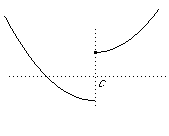 is the graph of a continuous function on the interval (a, b) of R
is the graph of a continuous function on the interval (a, b) of Rwhile
 is the graph of a function with a discontinuity at c.
is the graph of a function with a discontinuity at c.This intuitive concept needs a bit of tinkering to make it rigorous.
A continuous map stretches but does not to tear. Think of crumpling up the plane and then flattening it down.
You could even stretch it (a finite amount). The important thing is that close points are mapped to close points.
If you "tear" the plane, points which were close together on either side of the tear will be ripped apart and may not end up close: that is a discontinuity.
We will make all this at rigorous later.
Again, we will make of this at rigorous later, but here are some examples:


 in R3.
in R3.
But (amazingly) if you removed each of these knots from R3, the sets that are left are not homeomorphic.
It is things like this last example that spurred it topologists on to classification of things like knots.- The map
 from the interval (0, 2p] in R to the unit circle in C given by t
from the interval (0, 2p] in R to the unit circle in C given by t  eit is a continuous one-one map. It has a well-defined inverse.
eit is a continuous one-one map. It has a well-defined inverse.
What stops it being a homeomorphism?
Answer: the inverse map is not continuous at 1.
"Sticking the things" together means that you would have to tear them apart to define the inverse.